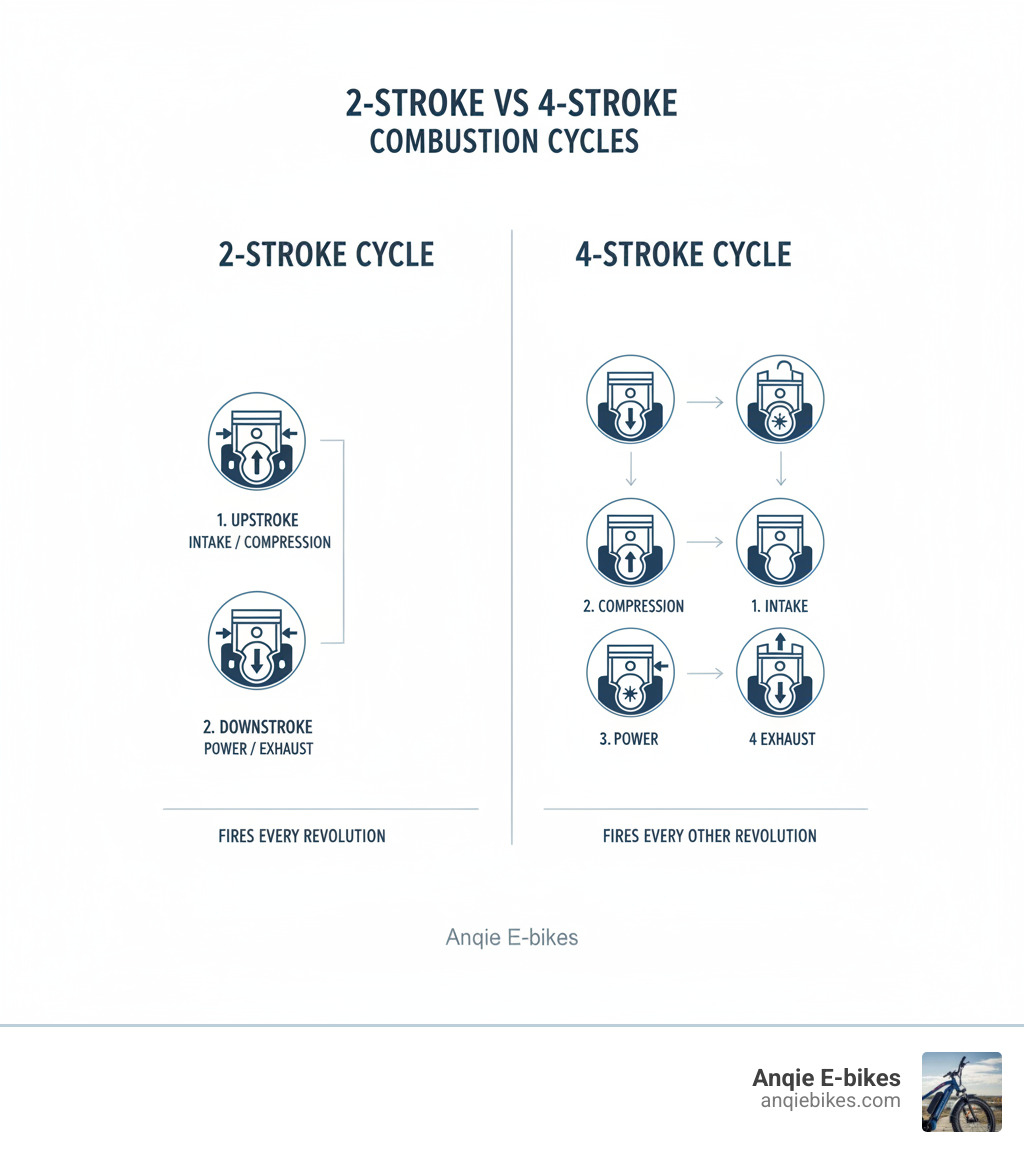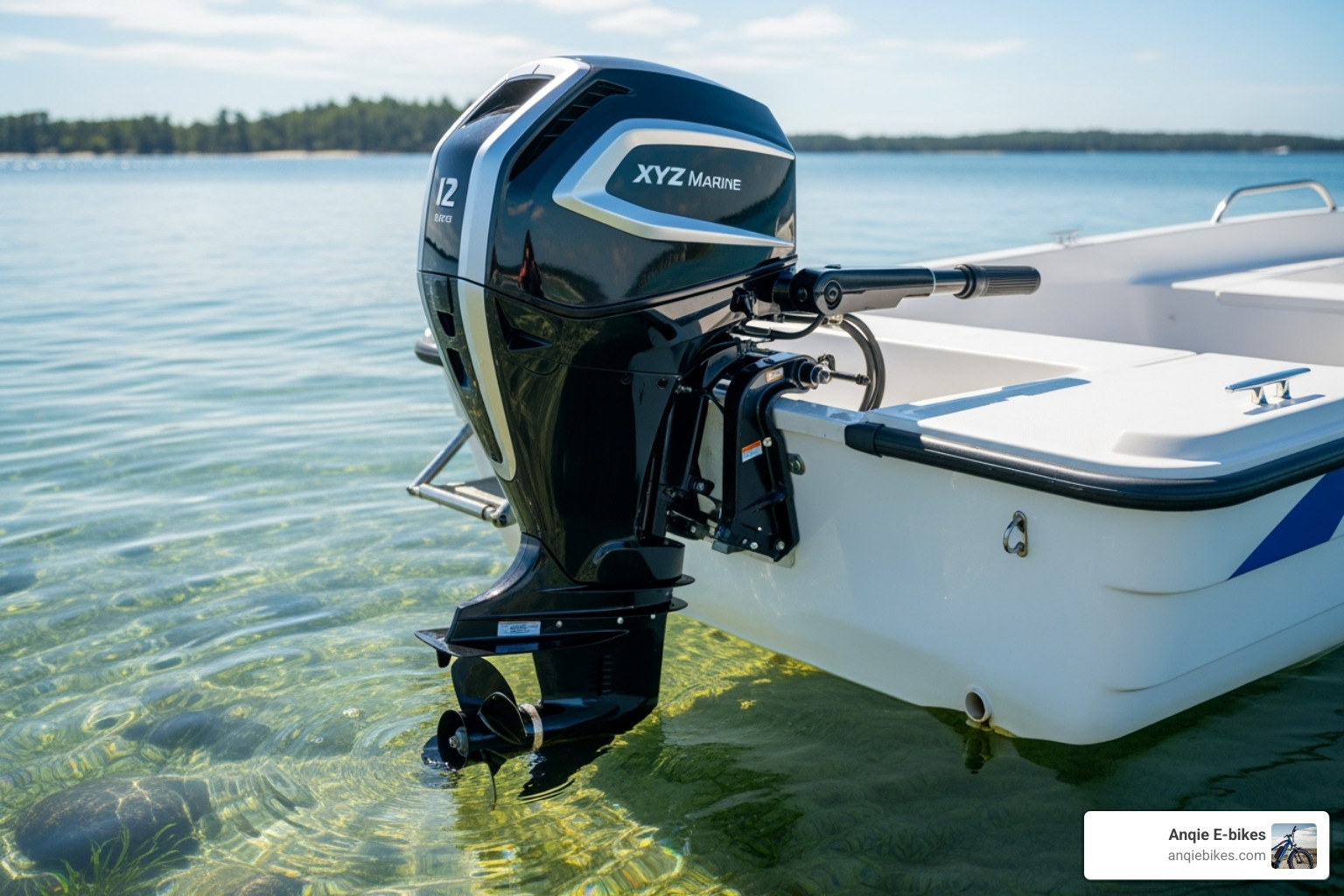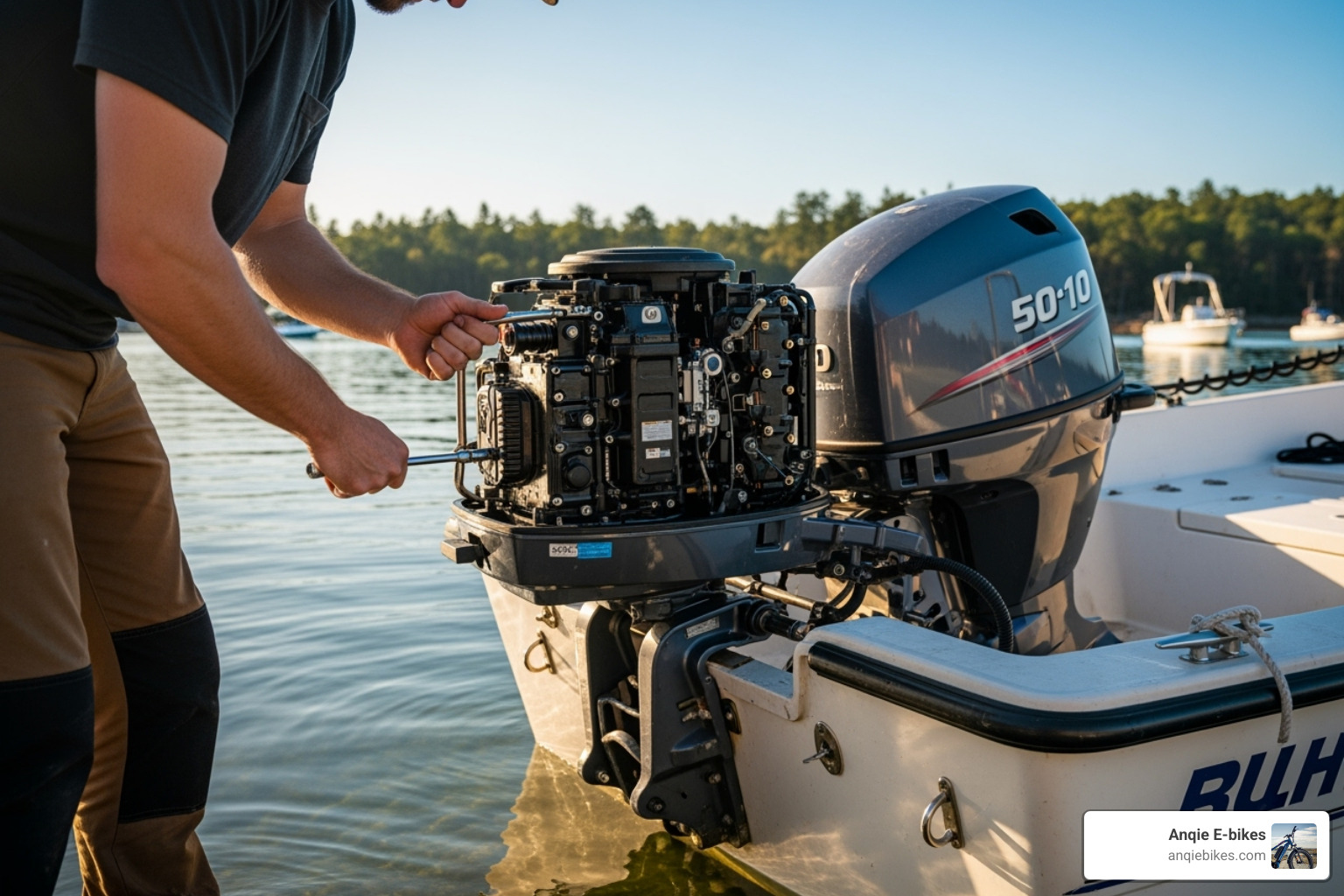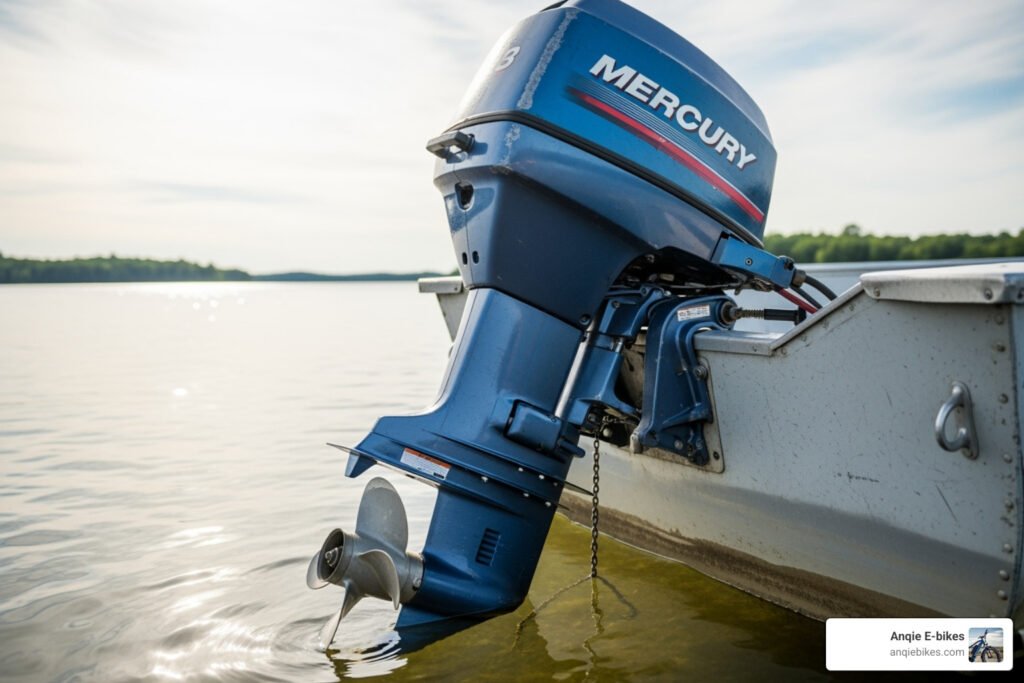Why 2-Stroke Outboard Motors Still Matter in Modern Boating
A 2 stroke outboard motor completes its power cycle in two piston movements, making it lighter and more powerful for its size than a 4-stroke motor.
Key Characteristics of 2-Stroke Outboard Motors:
- Lighter weight – Fewer internal parts mean less overall weight.
- Higher power-to-weight ratio – More power per pound than 4-stroke engines.
- Simpler design – No valves or camshafts to maintain.
- Quicker acceleration – Faster throttle response and top-end speed.
- Oil mixing – Oil is mixed with fuel (modern versions do this electronically).
- Available range – Typically 2.5hp to 250hp across manufacturers.
Modern vs. Traditional 2-Strokes:
Today’s 2-stroke outboards use direct fuel injection and electronic oil systems, solving old problems like poor fuel economy, smoke, and high emissions. The fuel economy of modern 2-stroke and 4-stroke engines is now comparable.
2-strokes excel where weight matters—portable applications, small fishing boats, and performance craft. Major manufacturers like Mercury, Yamaha, and Tohatsu still offer extensive 2-stroke lineups because they fill specific needs that 4-strokes can’t match.
This guide will help you understand if a 2-stroke outboard motor fits your needs. We’ll compare them to 4-strokes, explain how modern technology has transformed them, cover maintenance, and help you choose the right horsepower.
I’m Mark Stark, and my team at Anqie E-bikes has extensive marine industry expertise. We help customers select the ideal 2 stroke outboard motor for their unique requirements. Whether you’re an experienced sailor or just starting, we’re here to ensure you make a well-informed decision.

The Classic Showdown: 2-Stroke vs. 4-Stroke Fundamentals
The debate between 2-stroke and 4-stroke engines is a classic in boating. Understanding their fundamental differences is key to choosing the right motor, as the core mechanics remain distinct despite modern advancements.
How They Work: The Core Mechanical Differences
The name reveals the primary difference: the number of piston movements per power cycle.
A 2 stroke outboard motor completes a power cycle in two movements. The upstroke draws in a fuel/air/oil mix while compressing the mixture above. The downstroke is the power stroke, where the spark plug ignites the mixture, and as the piston drops, exhaust ports are uncovered. This simple design provides a power stroke with every crankshaft revolution. With no valve train or camshafts, it’s lighter and has fewer parts.
A 4-stroke engine requires four movements: intake, compression, power, and exhaust. This more complex process involves valves and camshafts, adding weight. It delivers a power stroke every other revolution but has a dedicated oil system for cleaner operation.
Historical Pros and Cons
Historically, choosing between these engines involved significant trade-offs.
The traditional 2 stroke outboard motor was prized for its power-to-weight ratio, making it ideal for smaller boats and those who valued quick acceleration. Firing on every revolution gave it a punchy feel, and its simple design meant easier maintenance.
However, older 2-strokes were loud, smoky, and inefficient. Unburnt fuel and oil created a blue haze and high emissions, and they consumed more fuel than 4-strokes. Their lifespan was often shorter due to less precise lubrication.
In contrast, 4-stroke engines were cleaner, quieter, and more fuel-efficient. Their separate oil system eliminated mixing and reduced emissions. They were generally more reliable long-term but were also heavier, bulkier, and had slower acceleration. Repairs could also be more complex.
Here’s how they stacked up historically:
| Feature | Historical 2-Stroke Outboard Motor | Historical 4-Stroke Outboard Motor |
|---|---|---|
| Weight | Lighter | Heavier |
| Acceleration | Quicker, more responsive | Slower, less punchy |
| Noise | Louder | Quieter |
| Emissions | Higher (smoke, unburnt fuel) | Lower, cleaner |
| Fuel Efficiency | Lower | Higher |
| Maintenance | Simpler (fewer parts) | More complex (valves, oil changes) |
Looking at A vintage outboard motor manual from the 1960s highlights how far technology has come. Modern 2 stroke outboard motor technology has addressed nearly all historical drawbacks, as we’ll explore next.
The Modern 2-Stroke Outboard Motor: Power and Efficiency Reimagined
The modern 2 stroke outboard motor is a far cry from the loud, smoky engines of the past. Modern engineering has transformed them, retaining their classic advantages while solving nearly all their historical problems.

The breakthroughs are Direct Fuel Injection (DFI) and electronic oil mixing. DFI injects fuel directly into the combustion chamber for a precise, efficient burn, while electronic oil injection delivers the perfect amount of oil based on engine load. These innovations have revolutionized 2-stroke performance, improving fuel economy, reducing emissions, and quieting operation to meet strict environmental regulations.
Key Benefits of a Modern 2-stroke outboard motor
Today’s 2 stroke outboard motor is appealing because its core strengths remain:
- Exceptional Power-to-Weight Ratio: With a simpler design and fewer parts, these engines deliver more power per pound. This is a significant advantage for small boats, inflatables, and tenders where weight is a critical factor.
- Thrilling Acceleration: Firing with every revolution, 2-strokes provide immediate and responsive power. This means getting on plane faster and navigating choppy water with more control.
- Lightweight and Portable: Their compact design makes them easier to mount, remove, and transport, which is a major benefit for anyone who moves their motor frequently.
- Simple and Reliable Structure: With no complex valve trains or camshafts, there are fewer components that can fail, translating to greater reliability on the water.
- Easier Maintenance: Electronic oil injection eliminates the need for oil changes, and with no valves to adjust, routine maintenance is more straightforward, meaning more time boating and less time in the shop.
How Modern Technology Addressed Old Drawbacks
Modern technology has impressively solved the historical issues of 2-stroke engines:
- Emissions Reduction: DFI ensures a more complete burn, drastically cutting emissions. Unburnt fuel and oil no longer escape into the environment, allowing these engines to meet stringent EPA and CARB regulations.
- Fuel Efficiency: Precise fuel delivery from DFI systems has made modern 2-strokes comparable in fuel economy to 4-strokes, increasing range and reducing fuel costs.
- Noise Dampening: Advanced acoustic engineering has tamed the classic 2-stroke roar into a much quieter and more pleasant sound.
- Reduced Smoke and Smell: Electronic oil injection eliminates the blue smoke and strong exhaust smell of older models by delivering the exact amount of oil needed, automatically and cleanly.
The bottom line is that today’s 2 stroke outboard motor offers the best of both worlds: legendary performance combined with the efficiency and clean operation modern boaters demand.
Maintenance, Cost, and Applications
Understanding the maintenance, costs, and best applications for a 2 stroke outboard motor is key to ownership. Their specific requirements are straightforward, making them an economical choice for many boaters.

Maintenance Requirements for a 2-stroke outboard motor
The simplicity of a 2 stroke outboard motor often means easier maintenance, but regular checks are crucial for reliability.
- Spark Plugs: Inspect regularly for fouling or wear and replace as needed. This is a simple, inexpensive task that prevents starting issues.
- Fuel System: Regularly check fuel lines for cracks and ensure the fuel filter is clean to prevent clogs. For older, carbureted models, periodic cleaning may be necessary.
- Oil Mixing: Older engines require careful pre-mixing of oil and fuel. Modern DFI engines have an electronic oil injection system; just keep the reservoir filled with the correct 2-stroke oil. There are no traditional oil changes.
- Water Pump Impeller: This critical cooling component should be replaced every one to two years to prevent overheating.
- Winterization: In colder climates, properly winterize your engine by stabilizing the fuel, fogging the cylinders, and draining the lower unit to prevent damage from freezing and corrosion.
Common Troubleshooting Steps for a Non-Starting Engine
If your 2 stroke outboard motor won’t start, a systematic check can often solve the problem.
- Check the Basics: Ensure there’s fresh fuel, the fuel line is connected, the primer bulb is firm, and the kill switch/safety lanyard is properly engaged.
- Inspect Spark Plugs: Check for fouling or damage. Clean or replace them if they are dirty or wet.
- Examine the Fuel System: Look for blockages or leaks. A clogged fuel filter is a common culprit. On DFI models, check the fuel pump; on carbureted models, the carb may need cleaning.
- Test the Ignition System: If you have fuel, check for a strong, blue spark. No spark points to an ignition system issue.
- Check Compression: If the engine has fuel and spark but won’t start, low compression could be the issue, indicating an internal problem.
For a more comprehensive guide, you can refer to resources like this: A detailed troubleshooting guide.
Comparing Purchase and Running Costs
The total cost of owning a 2 stroke outboard motor involves more than just the initial price.
- Initial Purchase Price: Historically cheaper, modern DFI 2-strokes are competitively priced. Our pre-owned options at Anqie E-bikes also offer great value.
- Fuel Consumption: Modern DFI 2-strokes are now comparable to 4-strokes in fuel economy, a significant improvement over older models.
- Oil Costs: A 2-stroke consumes oil continuously, which is an ongoing expense. A 4-stroke requires less frequent but larger oil changes. The overall cost can be similar over time.
- Maintenance Parts: The simpler design of a 2-stroke means fewer complex parts to replace, potentially lowering long-term maintenance costs. You won’t have to worry about valve adjustments or camshaft repairs.
- Long-Term Value: Both modern 2-strokes and 4-strokes are reliable with proper care. A well-maintained 2 stroke outboard motor will provide many seasons of faithful service.
The cost comparison is more nuanced today. Modern 2-strokes offer a balanced cost profile, and their performance advantages often provide excellent value for the right applications.
Frequently Asked Questions about 2-Stroke Outboards
Boaters often have questions about the 2 stroke outboard motor when weighing their options. Here are answers to some of the most common inquiries.
What horsepower ranges are typical for 2-stroke outboards?
A 2 stroke outboard motor is available in a wide range of horsepowers to fit various needs.
- Portable (2.5hp to 20hp): These lightweight, compact engines are perfect for tenders, inflatables, canoes, and jon boats where portability is key. Their quick acceleration is also a plus.
- Mid-Range (25hp to 90hp): This range powers many fishing boats, skiffs, and recreational craft, offering a great balance of power and weight to get on plane quickly.
- High-Power (150hp to 250hp): While less common in some recreational markets, these are valued in performance boats and commercial applications for their exceptional power-to-weight ratio. Their simple design makes them practical for remote work.
Are 2-stroke outboards bad for the environment?
This is a common question, but it’s important to distinguish between past and present technology.
Historically, carbureted 2-strokes were less environmentally friendly, releasing unburnt fuel and oil. This created the smoke and smell many people associate with these engines.
However, modern 2 stroke outboard motors with Direct Fuel Injection (DFI) are completely different. Spurred by EPA regulations and CARB ratings, DFI technology allows for a precise, clean burn. Compared to older models, today’s DFI 2-strokes have dramatically lower emissions, produce virtually no smoke, and are significantly more fuel-efficient. A modern DFI 2-stroke is a clean-burning engine that meets or exceeds the emissions standards of many 4-strokes.
What are the best applications for a 2-stroke motor?
A 2 stroke outboard motor excels in specific applications due to its unique strengths.
- Fishing Boats: The quick acceleration and lighter weight are ideal for smaller fishing boats like jon boats and bass boats, improving performance and handling.
- Inflatables and Tenders: The lightweight, compact design is a huge advantage when you need to frequently mount, remove, and store the motor.
- Performance Boats: For those who love instant throttle response and exhilarating speed, a 2-stroke delivers a punch that is hard to match.
- Utility and Work Boats: In commercial or remote settings, their rugged simplicity and ease of maintenance are significant benefits.
In short, any situation needing a high power-to-weight ratio is where a 2-stroke shines. If portability, quick acceleration, and a lightweight design are your priorities, a 2 stroke outboard motor is likely your best choice.
Conclusion
It’s clear the modern 2 stroke outboard motor has evolved far beyond its smoky ancestors. Thanks to Direct Fuel Injection and electronic oil mixing, today’s 2-strokes are powerful, efficient, and clean-burning machines. They deliver their legendary quick acceleration and impressive power-to-weight ratio with fuel economy and emissions that rival 4-strokes.
The choice between a 2-stroke and a 4-stroke now comes down to your specific needs. If you value a lightweight design for a tender, instant throttle response for a fishing boat, or simpler maintenance, a 2 stroke outboard motor is an excellent choice.
Major manufacturers continue to innovate 2-stroke technology because its unique combination of power, speed, and portability remains in high demand. From jon boats to performance craft, these engines fill a vital role in the marine world and will continue to do so for years to come.
At Anqie E-bikes, we know choosing an outboard is a big decision. Our expert team can guide you through our new and pre-owned options to find the perfect 2 stroke outboard motor for your needs. We’ve helped countless boaters in the Brooklyn NY area and beyond make the right choice with confidence. Stop by our store or browse our selection online for expert guidance and exceptional service.
